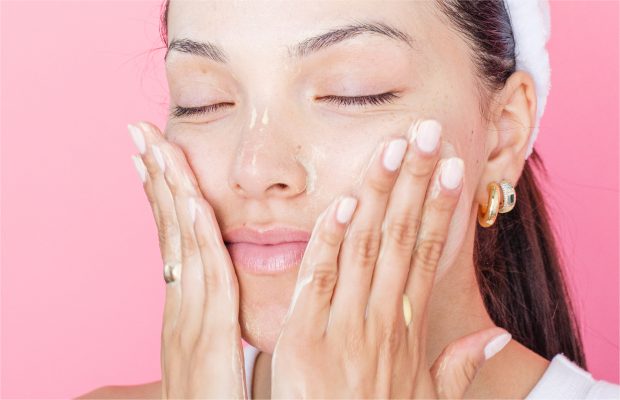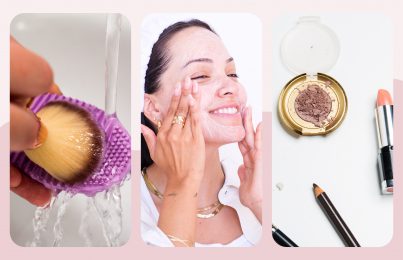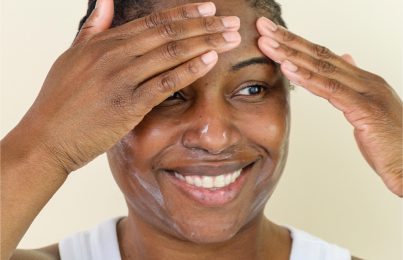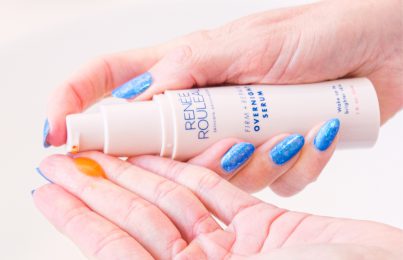Updated 08/08/24. To get the most out of your nighttime skincare routine, you must choose the right products for your skin type, and use them as directed and in the right order. This is sure to give you the best results and create the most improvement in your skin while you sleep. After all, it’s called “beauty sleep” for a reason!
In this post, you’ll learn the exact order you should be applying your products for the perfect nighttime skincare routine. I’ve also included some helpful tips and answers to FAQs to clear up any confusion you might have. Let’s go!
5 Guidelines for an Effective Nighttime Skincare Routine
- Your evening skincare routine should be slightly different from your morning skincare routine. That’s because your skin has different needs at different times of day (did you know your skin has its own circadian rhythm?). Daytime is all about protection. Nighttime is all about repair.
- The main focus of your nighttime routine should be to provide your skin with what it needs to aid in repair processes.
- You should try to perform your routine rather quickly. In fact, you have a one-minute window after cleansing to apply your next product. Otherwise, you risk moisture loss. I call this the “Golden Minute Rule.”
- Don’t skip out on moisturizer at night, thinking you’re skin needs to “breathe.” Your skin doesn’t have a respiratory system, so this is a myth. If you skip moisturizer, you’re setting your skin up for water loss.
- As I said before, it’s so important to choose products formulated for your specific skin type! If you don’t know your skin type, take the Skin Type Quiz to find out.
How Your Skin Functions in the Evening
- Skin cells have the lowest water content
- The skin’s natural barrier function decreases, which means the skin is more permeable
- Your skin’s detox enzymes are released
- The rate of cell growth and division increases
- Mitochondrial energy is renewed
- DNA repair and renewal processes are active
The Correct Order To Apply Nighttime Skincare Products
Step 1: Cleanser (Preferably a Cleansing Lotion)
At night, you need to use a cleanser to wash away all the sunscreen, makeup, and sebum that has collected on your skin throughout the day. Did you know that it’s thought that the face is the dirtiest part of the body since we tend to unknowingly touch our faces, transferring dirt and bacteria, throughout the day?
I always suggest using a cleansing lotion or this cleansing balm as part of a nighttime skincare routine. The reason I recommend this (and not a foaming gel cleanser) is because it does a better job of dissolving makeup, sunscreen, dirt, and debris. It’s important to apply them to dry skin, so they don’t become diluted. This way, the emollients in the cleanser will attach themselves to emollients used in makeup to properly break them down.
Only after you’ve massaged a cleansing lotion onto dry skin for 30 seconds, wet your fingers, and massage through once more. From there, rinse with water, and give your skin a final wipe with a soft washcloth. The result? Clean, fresh-feeling skin.
Read how to wash your face at night.
I don’t recommend using cleansing oils or balms, in fact, I hate them. Read why I hate cleansing balms.
Step 2: Mask (Optional)
Many people like to use a mask as part of their nighttime skincare routine, and I’m one of them. A mask is beneficial for resetting the skin—especially if you’ve been on an airplane, wearing makeup, had a lot of sun exposure, or are experiencing breakouts. After cleansing at night, apply a mask and leave it on anywhere from 5-20 minutes. Rinse well and proceed to the next step.
I alternate between a few different masks depending on what my skin needs. Here are the masks I recommend:
- If you’re experiencing breakouts, use the Rapid Response Detox Masque.
- If you want to clear pores and refresh oily/combination skin, use the Energizing Cleansing Masque.
- For moisturizing dry skin, use the Rest Day Masque.
Read the different types of facial masks and their benefits.
Step 3: Toner
Toners are misunderstood, but they are very important to use and serve many purposes for the skin. In fact, they serve five major purposes. Just make sure you’re using an alcohol-free toner, as they’re generally more gentle and hydrating than alcohol-based toners. The latter are often drying and irritating, especially to sensitive skin types.
Apply all over the face using a thin toning cloth to avoid product waste. Leave it damp on the skin and go to the next step.
Step 4: Serum
Using a specialized serum at night will go a long way. That’s because the skin’s permeability is increased at night, which means it’s able to absorb products more efficiently. Use one that you get from a reputable and ingredient-focused skincare brand and that contains active ingredients to give the skin what it needs to support its natural repair processes overnight.
One serum I recommend to my clients and I personally use is the Firm + Repair Overnight Serum. It contains a powerful blend of peptides, antioxidants, and skin-soothing algae extracts. Just like with any serum, I apply it, let it absorb for 60 seconds, and then move on to moisturizer.
Step 5: Moisturizer
I don’t believe there is really such a thing as a “night cream.” In my opinion, a night cream is any moisturizer that doesn’t include sunscreen. They don’t have to be greasy or heavy (it’s a myth that a heavy moisturizer is better for wrinkles), but it does need to be formulated for your specific skin type.
If you don’t know your skin type, take the Skin Type Quiz! At the end of it, you’ll get a personalized moisturizer recommendation.
Step 6: Eye Cream (Optional)
I’m a huge believer in eye creams, especially when it comes to a nighttime skincare routine. After all, the skin in the eye area is thinner than the skin in other areas of the face. That’s one of the reasons why it’s often the very first area to show visible signs of aging like lines and wrinkles.
While the use of nourishing eye cream, like the Hydrabounce Firming Eye Creme, is important to keep the area firm and moisturized, eye cream alone isn’t enough. If you’re serious about preventing eye-area lines and wrinkles, you need to remove dryness and crepey-ness with an exfoliant. For that, I recommend using the Overnight Eye Serum. It’s safe to use on the delicate skin around the eye area, and it can soften the look of lines and wrinkles.
Step 7: Spot Treatment (Optional)
If you want to spot treat breakouts, take a damp cotton swab or tissue and wipe the area to remove the skincare products that you just applied. Then, apply the spot treatment and let it dry. That’s it! That’s all it takes to effectively spot treat breakouts in your nighttime skincare routine. (Just make sure you’re using the right one…Otherwise, you could actually make your blemishes last longer!).
The Night Time Spot Lotion is a powerful spot treatment. It goes to work while you sleep, quickly improving the look of blemishes with a potent blend of camphor, sulfur, and zinc oxide.
Step 8: Face Oil (Optional)
Face oil is a great way to prevent moisture evaporation for people with dry skin types or those who live in low-humidity climates. If it’s applied on top of a moisturizer, it acts as a protective seal to keep moisture locked in the skin.
It’s essential that you use face oil as the very last step in your routine. Many people make the mistake of using face oil too early, which can cause problems and render your products less effective. Read more about how to properly use face oil.
Step 9: Hang Your Head Upside Down for 2 Minutes
It might sound strange, but this is my favorite trick for glowing skin. I simply hang my head off the side of my bed each night to boost circulation to my face and encourage a healthy-looking glow. I do this every night and consider it an important part of my nighttime skincare routine.
Frequently Asked Questions
Here are a few FAQs I get asked concerning people’s nighttime skincare routines.
Can I Use the Same Cleanser Both Morning and Evening?
If you don’t wear makeup, you can use a gentle foaming cleanser twice a day. However, if you do wear makeup, I recommend using a cleansing lotion in the evening. Even if you don’t wear makeup, you should be wearing sunscreen, and cleansing lotions are better at removing that, too.
I Have a Prescription Acne Medication. When Would I Apply That?
Consult your doctor to find out when you should apply your prescription medication in your nighttime skincare routine.
Should I Incorporate a Skin Device Into My Routine?
It’s only natural to consider incorporating a skin device into your nightly routine, especially since there are so many on the market these days! I can’t say for certain whether it’s worth it to incorporate one or not; that really depends on the specific device you’re talking about. However, for some direction, be sure to read my review of 10 popular skincare devices.
There you have it. If you follow my advice and perform your evening skincare routine with the right products for your skin type and in the right order, you’ll get the very best results!
Next, learn how to create the perfect morning routine.
Celebrity Esthetician & Skincare Expert
As an esthetician trained in cosmetic chemistry, Renée Rouleau has spent 35 years researching skin, educating her audience, and building an award-winning line of products. Her hands-on experience as an esthetician and trusted skin care expert has created a real-world solution — products that are formulated for nine different types of skin so your face will get exactly what it needs to look and feel its best. Trusted by celebrities, editors, bloggers, and skincare obsessives around the globe, her vast real-world knowledge and constant research are why Marie Claire calls her “the most passionate skin practitioner we know.”




Comments:
I think I’m between a skin type 4 and a 6 which is sort of confusing me….I’m sort of taking bits and tips from each section and using them if they apply to me. Do you recommend waiting 15-20 minutes after retinol and or acids are applied at night before putting on moisturizer? Also, do you put on toner before or after retinol or acids at night or not at all? I thought with retinol you were supposed to put it on dry skin….I use Shani Darden’s retinol reform.
Posted By: ali |
Great question! We suggest applying toner before any serums, retinol included. It does help get the best benefits from your retinoid to wait at least three minutes before applying your moisturizer.
Posted By: Ella Stevenson |
Great question! I suggest applying toner before any serums, retinol included. It does help get the best benefits from your retinoid to wait at least three minutes before applying your moisturizer.
Posted By: Ella Stevenson |
Hi! I have been using the Soothing Aloe Cleansing Milk since July 2009. It doesn’t completely remove makeup – at least, not on the first attempt. And, even on the second attempt, Soothing Aloe Cleansing Milk *still* doesn’t remove all of it. I don’t know about others, but, when I swipe my face with my toner, I expect the cloth to be virtually makeup-free. If one is wearing sunscreen, primer, concealer, color corrector, foundation, bronzer, powder, eye shadow, eyeliner, mascara, brow tint, and a setting spray, Soothing Aloe Cleansing Milk isn’t going to completely dissolve and remove all of that. One needs to use a good cold cream first, then, follow with Soothing Aloe Cleansing Milk.
Posted By: teachermrw |
Hi! Sorry to hear the Soothing Aloe Milk isn’t fully removing your makeup. Make sure to massage it into dry skin first to break everything down, then wet fingers and continue to massage. If you’re wearing heavier makeup like primer etc., I recommend trying our Vitamin-Infused Cleansing Emulsion. It’s a bit richer and able to break through more heavy-duty products.
Posted By: Renée Rouleau |